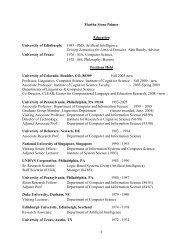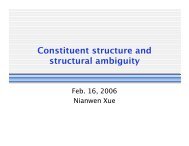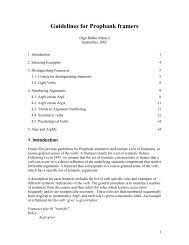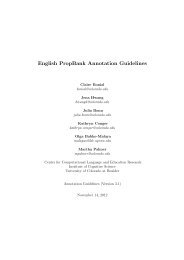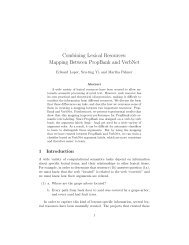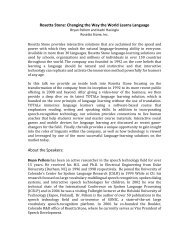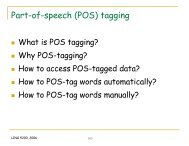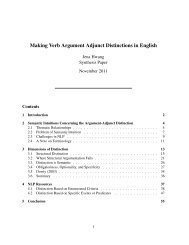Hindi PropBank Annotation Guidelines December ... - Verbs Index
Hindi PropBank Annotation Guidelines December ... - Verbs Index
Hindi PropBank Annotation Guidelines December ... - Verbs Index
Create successful ePaper yourself
Turn your PDF publications into a flip-book with our unique Google optimized e-Paper software.
2.4.2 <strong>Annotation</strong> using Cornerstone<br />
The screenshot below (as well as in the figures 1-4 above) shows the tool Cornerstone<br />
which is used to create a framefile. Cornerstone may be accessed at<br />
/home/verbs/shared/propbank/cornerstone. Make sure that you use version 1.35.<br />
Figure 5: A screenshot of the tool Cornerstone<br />
Below, we outline the format for entering values in each of the fields seen in<br />
Cornerstone above:<br />
Frameset note: This field is used to enter the verb LEMMA in Devnagari script (the<br />
script that is used to write <strong>Hindi</strong>). The lemma is the citation form of the verb (in <strong>Hindi</strong>,<br />
this is the bare form of the verb, e.g. "खा " KA ‘eat’, and not its inflected forms, e.g.<br />
"खाया " KayA ‘ate’).<br />
Frameset tabs: Here we enter different forms of the verb’s lemma (in Romanized<br />
script) based on its transitivity, causativization and its involvement in complex<br />
predication. In the example above, we can see that KA 'eat' becomes KilA ‘make<br />
someone eat’ (i.e. ‘feed’) and KilavA ‘cause someone to feed someone else’. Each of<br />
these will get a separate predicate frame as mentioned in section 2.1. above. If the verb<br />
appears as a support verb (alternatively known as a light verb) in a complex predicate,<br />
e.g. the verb kara in the complex predicate snaan kar ‘bath do’ then we will enter<br />
"kara_LV" as one of the predicate frames (see section 7 for more details).<br />
12



